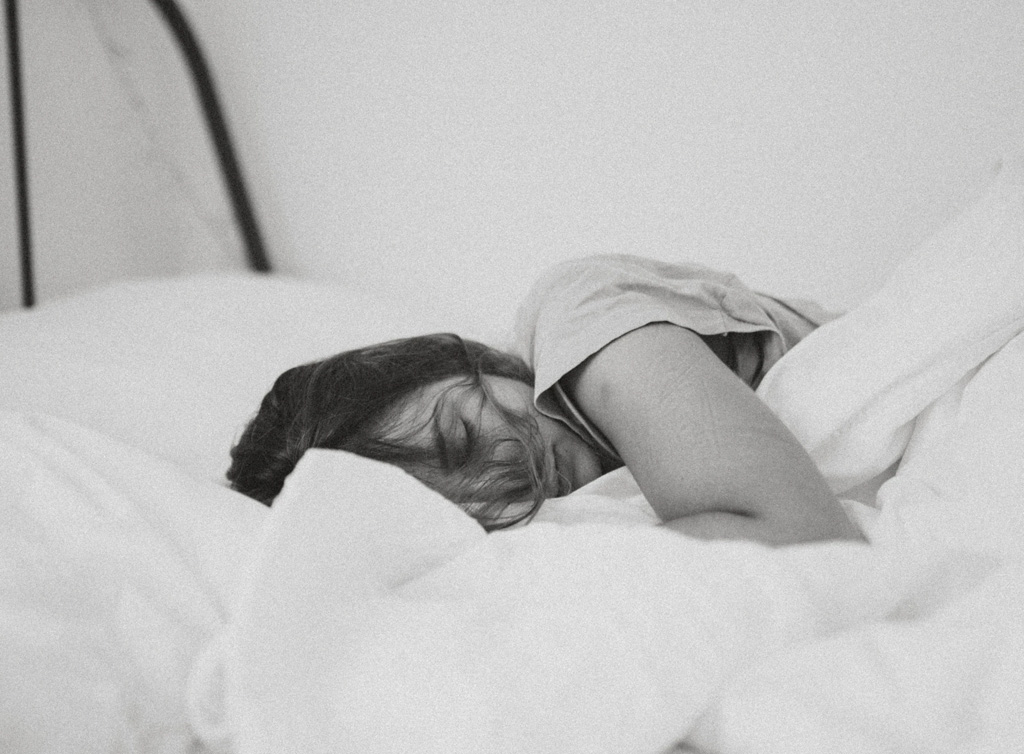I had never given much thought to sleep, until, one day, like Dorothy Parker, I seemed to lose the knack for it. Sleeping became an issue about the time my marriage collapsed. Understandable really. Yet four years later, with my relationship issues largely resolved, I was still tossing and turning into the early hours. It was as if a gang of little monsters would arrive the moment my head hit the pillow to churn through every last worry and try to solve all my problems. I tried lavender oil, reading myself to sleep and, eventually, sleeping pills. There was a brief moment of respite following a shamanic retreat, but then, after a run-in with jet lag, anxiety crept back into my bed. I saw a therapist, who prescribed Zopiclone sleeping pills. They worked like a dream — for about five minutes. Then, gradually, I started upping the dose. When I caught myself washing them down with a glug of red wine, I knew it was time to stop.
When you are pacing the boards at 4am, insomnia is a lonely place. Jamie Oliver recently talked about his night-time travails after being woken up by his children. His solution was to launch a website, Up All Hours, so that insomniacs could find solace in each other’s company. The rest of us seek help from our GP. Every year, more than 10m prescriptions for sleeping pills are given out in England. In 2010-11 it cost the NHS almost £50m. “I would say it’s down to the recession,” says Dr Guy Meadows, the founder of the Sleep School, who has teamed up with the Corinthia Hotel for its The Power of Sleep project, launched last month.
Like me, 60% of insomniacs first encounter sleep problems following a stressful life event, while 20% say pregnancy was the trigger. Most people gradually return to their normal sleep patterns once the stress has gone, but for a small percentage insomnia becomes entrenched. These are the people Meadows treats at his sleep school. After 12 years as a physiologist devoted to sleep research, he found that traditional sleep therapies, such as cognitive behaviour therapy (CBT) and sleep-hygiene tips, were largely ineffective. “If you are a normal sleeper, sleep-hygiene tips like blacking out windows and going to bed at the same time every night can help, but if you worry about sleep, they don’t.”
The main thrust is: do nothing. Step one is to accept your insomnia
He describes his clients’ bedside tables as a mausoleum of failed tools and techniques. “The thing about sleep is that it’s a subconscious process. You can’t switch it on and off at will. But the awesome thing about humans is that we are born strugglers, we are fighters.
We think, ‘What can I do about this problem?’ So we surf the net for a solution, and that’s when the sleep guidelines come out. My classic client has stopped drinking alcohol. They will have a warm drink before bed, a hot bath, lavender spray on their pillow.
They might even have taken up marathon running with the sole intent of tiring themselves out.”
When the usual tricks fail, desperation sets in. One of Meadows’s clients would line up six shots of vodka — one for every time she woke up; another frequented cemeteries at night, hoping a good cry might do the trick; yet another felt compelled to lie naked on cold tiles.
The problem with all these remedies, Meadows says, is that any kind of “action” can backfire, triggering the flight or fight response — the last thing you need when you are trying to drop off. “The amygdala, the prehistoric part of the brain in charge of emotions, takes one look at all the effort we’re going to to deal with this problem and thinks, ‘No one runs away that hard from something unless it’s pretty damn dangerous. I’d better stay awake or I’m going to get eaten.’ ” Pretty soon, the chronic insomniac only has to look at a bed for the alarm bells to go off. Their heart starts racing and they get a knot in their stomach. “It’s a conditioned response,” Meadows says. “We’re like Pavlov’s dogs.”
It sounds like a hopeless situation, but once you understand how the body works, you are on the road to recovery, says Meadows, who outlines his own five-week sleep plan in The Sleep Book: How to Sleep Well Every Night. The main thrust is: do nothing. Step one is to accept your insomnia. In fact, not just accept it, but embrace it like a long-lost friend. It sounds bonkers, but Meadows says that welcoming your insomnia is the key to breaking the vicious cycle and getting you back to sleep. He is pioneering the use of mindfulness and Acceptance and Commitment Theory (ACT) in the treatment of insomnia.
Ironically, Meadows had his “Aha” moment when he was hit by his first bout of insomnia. “I’d been seeing people who couldn’t sleep, day in, day out. Then, one day, I had the uncomfortable thought: ‘What if I can’t sleep?’ ” Before long he was awake at night, worrying. CBT didn’t work. “I would try to block the thought, but the harder I tried to block it, the stronger it became.”
He finally realised that worrying about insomnia and trying to do something about it was making it worse. His theory was cemented when he noticed that many of his clients reported they fell asleep, after struggling all night, just before they were due to get up. “I’d ask them, ‘What happened at that point?’ and they would tell me they had just given up. It was only when they gave up the struggle to sleep that they could finally nod off,” Meadows says.
Could his theory work for me? It was worth a try certainly, but, first, I had to drop my sleep “props”. Booze and pills were verboten, obviously, but the lavender oil and comforting Buddhist books also had to go. It was just me and my demons facing the night alone. Pretty scary stuff, but Meadows was persuasive. If I had the courage to slog it out alone, I would feel lighter and more relaxed.
At 4am, when I woke up, instead of mulling over the disastrous consequences of not sleeping, I noticed my thoughts and labelled them, as Meadows advised. The idea is that by creating a distance between me and my demons, they will have less power to torment and keep me awake. Sure enough, they were out in force: there was Deadline Disaster (that I will fall behind with work), Grumpy (my day will be ruined) and Hopeless (I will be unable to cope). And the relationship rabble: poor old Lonely Heart (no one will love me ever again) and Bad Mother (my marriage break-up has ruined my children’s lives).
Usually, I toss and turn, thinking how unfair the whole thing is. Why can’t I sleep? Everyone else can (Poor Me). Now, instead of lying there fretting, I greeted my demons in a friendly manner: “Come on in,” “Good to see you!” Then I turned my attention back to my breathing and my senses, using the mindfulness techniques outlined in the book. Despite billing mindfulness as a “revolutionary way to conquer insomnia”, the point of these exercises is not to get to sleep, but to end the battle with the insomnia. The idea is that we should “own” our pain, and in doing that we give up the fight. And, of course, a happy by-product of mindfulness is that it slows the breathing, so you’re more likely to feel sleepy.
It was quite fun thinking of silly names for my demons. It certainly lightened the mood. And not worrying about not sleeping was a huge relief. I wasn’t expecting miracles, as I had jet lag on top of my usual sleep worries. Day one, I woke at 4am, and I didn’t drop off again until dawn, but it wasn’t too bad. It was certainly more fun making up silly names for my demons than tossing and turning, and that’s when I twigged: it’s not the being awake that’s so horrible, it’s the fretting about it that hurts.
The next day I cheated a bit by reading The Sleep Book in bed and dropping off early, but I was wide awake again at 5am. I was just settling into my mindfulness exercises, labelling my thoughts, focusing on my senses and thinking about the sheets on my skin, when I was interrupted by my daughter at the bedroom door: “Mum, get up, it’s half past seven.” Extraordinarily, for the first time in years, I had overslept. We were late for school and I was over the moon.
Get a good night’s sleep every night
1 Accept your insomnia and stop fighting it.
2 Gradually wean yourself off sleep props, such as pills, reading and rituals.
3 Use mindfulness to notice your thoughts and emotions without judging them. This will loosen the grip they have on you.
4 Activate the “welcome response”. Embrace your fears like old friends. Label them. Be playful, say: “Oh, there you are Failure, there you are Relationship.” It sounds odd, but Meadows suggests singing your fears to the tune of Happy Birthday as a strategy to break their power.
5 Pay attention to sleep hygiene, such as room temperature and light, and go to bed and get up at roughly the same time every day. Everyone takes a short time to go to sleep and wakes at least once or twice a night. Don’t spend longer in bed than you need to, it can reduce the quality of your sleep.
Click here to read the original article →




